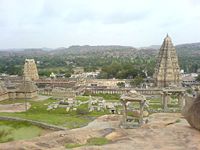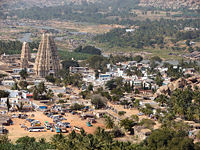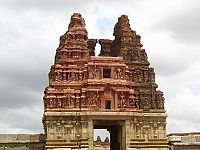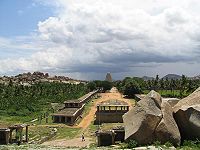Hampi
| Group of Monuments at Hampi* | |
|---|---|
| UNESCO World Heritage Site | |
| State Party | |
| Type | Cultural |
| Criteria | (i)(iii)(iv) |
| Reference | 241 |
| Region** | Asia-Pacific |
| Inscription history | |
| Inscription | 1986 (10th, 15th Session) |
| * Name as inscribed on World Heritage List. ** Region as classified by UNESCO. | |
Hampi (Kannada: ಹಂಪೆ, Hampe in Kannada) is a village in northern Karnataka, the name is a corruption of Pampa, which is the puranic name of the Tungabhadra River on whose banks the city is built. Hampi is located within the ruins of Vijayanagara, the former capital of the Vijayanagara empire. Possibly predating the city of Vijayanagara, this village continues to be an important religious centre, housing the Virupaksha Temple. The village of Hampi contains several other monuments belonging to the old city. It extends into some of the old ceremonial streets of Vijayanagara. As the village is at the original centre of Vijayanagara, it is sometimes confused with this ruined city. Hampi is also called "The City of Ruins". The Vijayanagara ruins are listed as the Group of Monuments at Hampi as a UNESCO World Heritage Site.[1]
The name "Hampi" is an anglicized version of the Kannada Hampe (derived from Pampa, the ancient name for the Tungabhadra river). Over the years, it has also been referred to as Vijayanagara and Virupakshapura (from Virupaksha, the patron deity of the Vijayanagara rulers).
History

Hampi is identified with the mythological Kishkindha, the Vanara (monkey) kingdom which finds mention in the Ramayana. The first historical settlements in Hampi date back to 1 C.E.
Hampi formed one of the cores of the capital of the Vijayanagara empire from 1336 to 1565. It was destroyed by Moslem emperors. Hampi was chosen because of its strategic location, bounded by the torrential Tungabhadra river on one side and surrounded by defensible hills on the other three sides.
The site is of great importance in terms of architecture and Historical significance. The demography is abundant with large stones which have been utilized to make larger than life statues of god. One can see a structure of historic importance every quarter of a mile.
Sadly the city is in ruins as it was not able to defend itself against Islamic aggressions who treat Idol worship as blasphemy, 'all' the idols have been destroyed or damaged, the successive governments have not been able to keep the place free from treasure seekers who claim further damage.
Recently the Archaeological Survey of India is conducting continous excavations in the area to discover more artifacts and temples.
Geography
Hampi is situated on the banks of the Tungabhadra river. It is 353 km from Bangalore, 254 km from Bijapur and 74 km away from Bellary. Hospet, 13 km away, is the nearest taluka headquarters. The chief language spoken is Kannada. The principal industries of the village are agriculture, the support of the Virupaksha temple and some other local holy places in the vicinity, and tourism. The annual Vijayanagar Festival is organized by the Government of Karnataka in November. Due to the presence of several mineral deposits in this region (iron-ore, manganese), mining of these minerals has been going on for many years now. But a recent boom for the supply of iron-ore in the international market has led to excessive mining in this district. The World Heritage Site at Hampi as well as the Tungabhadra Dam are now under threat.
The City has been given Limited connectivity to preserve the character with scarce elctricity, no GSM network coverages and amenities, still it is becoming a popular tourist destination as on Oct 2007
Important sites at and near Hampi
- Achyutaraya Temple/Tiruvengalanatha Temple
- Akka Tangi Gudda
- Anegondi
- Anjeyanadri Hill
- Aqueducts and Canals
- Archaeological Museum, Kamalapura
- Badava Linga
- Balakrishna Temple
- Bhima’s Gate
- Bhojanasala
- Chakratirth
- Chandrashekara temple
- Coracle crossings
- Danaik's enclosure
- Elephant Stables
- Ganagitti Temple
- Gejjala Mandapa
- Guard’s quarters
- Hampi bazaar
- Hazara Rama temple
- Hemakuta Hill
- Jain temples
- Kadale Kalu Ganesha
- Kings Audience Hall
- Kondarama Temple
- lotus mahal[1]
- Mahanavami Dibba
- Malayavanta Raghunatha temple
- Malyavanta Hill
- Matunga Hill
- Mint
- Octagonal bath
- Octagonal Water pavilion
- Pampa Sarovar
- Pattaabhi Rama temple
- Purandaradasa mandapam
- Pushkarani or the Stepped Tank
- Rishimukh
- Royal enclosure
- Saraswati Temple
- Sasive Kalu Ganesha
- Sita Konda
- Sugriva's Cave
- The Kings’ balance
- The Underground Temple
- Tungabhadra River
- Uddana Veerabhadra temple
- Ugra Narasimha
- Virupaksha Temple
- Vittala temple
- Yeduru Basavanna
- Yentrodharaka Anjaneya temple
- Zenana enclosure
- Virupapurgadde
Temples
Hampi has various notable Hindu temples, some of them which are still active places of worship. Some of them are:
- Virupaksha Temple complex: Also known as the Pampapathi temple, it is a Shiva temple situated in the Hampi Bazaar. It predates the founding of the Vijayanagar empire. The temple has a 160 foot high tower at its entrance. Apart from Shiva, the temple complex also contains shrines of the Hindu goddesses Bhuvaneshwari and Pampa.
Pictures
- Another Hampi Monument.jpg
Vijay Vittal Temple
- Hazara Rama rearview DK.jpg
Hazara Rama Temple
- Stonechariot Vitthala hampi.jpg
Stone chariot
- Harara Rama templepillars DK.jpg
Pillars at Hazara Rama temple
- HazaraRamatemple Blackgranite DK.jpg
Granite pillars at Rangamantapa
- Harara Rama Bow DK.jpg
Rama breaking Siva bow
See also
- Vijayanagara
- Vijayanagar Architecture
- Krishna Deva Raya
- Vidyaranya
- Kanakagiri
Notes
- ↑ Group of Monuments at Hampi. World Heritage. Retrieved 2006-12-20.
ReferencesISBN links support NWE through referral fees
- T.S. Satyan, Hampi: The fabled capital of the Vijayanagara Empire, (Directorate of Archaeology and Museums), Govt. of Karnataka, 1995
- J.M. Fritz et al, New Light on Hampi: Recent Research at Vijayanagara, (Performing Arts Mumbai, 2001) ISBN 81-85026-53-X
- A.N. Longhurst, Hampi Ruins Described and Illustrated, (Laurier Books Ltd., 1998) ISBN 81-206-0159-9
- The Ruins of Hampi:Travel Guide ISBN 81-7525-766-0
Articles and Travelers experiences
External links
- Map at Wikimapia
- Group of Monuments at Hampi - Unesco page
- Karnataka.com - hampi
- A Guide to History and Tourism at Hampi
- www.Hampi.in : A website dedicated to info on Hampi.
| ||||||||||||||||||||||||||
| |||||||
Credits
New World Encyclopedia writers and editors rewrote and completed the Wikipedia article in accordance with New World Encyclopedia standards. This article abides by terms of the Creative Commons CC-by-sa 3.0 License (CC-by-sa), which may be used and disseminated with proper attribution. Credit is due under the terms of this license that can reference both the New World Encyclopedia contributors and the selfless volunteer contributors of the Wikimedia Foundation. To cite this article click here for a list of acceptable citing formats.The history of earlier contributions by wikipedians is accessible to researchers here:
The history of this article since it was imported to New World Encyclopedia:
Note: Some restrictions may apply to use of individual images which are separately licensed.








